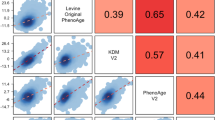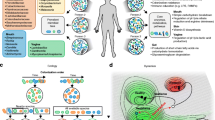Abstract
Although systems biology is a perfect framework for investigating system-level declines during aging, only a few reports have focused on a comprehensive understanding of system-level changes in the context of aging systems. The present study aimed to understand the most sensitive biological systems affected during aging and to reveal the systems underlying the crosstalk between aging and the ability of calorie restriction (CR) to effectively slow-down aging. We collected and analyzed 478 aging- and 586 CR-related mouse genes. For the given genes, the biological systems that are significantly related to aging and CR were examined according to three aspects. First, a global characterization by Gene Ontology (GO) was performed, where we found that the transcriptome (a set of genes) for both aging and CR were strongly related in the immune response, lipid metabolism, and cell adhesion functions. Second, the transcriptional modularity found in aging and CR was evaluated by identifying possible functional modules, sets of genes that show consistent expression patterns. Our analyses using the given functional modules, revealed systemic interactions among various biological processes, as exemplified by the negative relation shown between lipid metabolism and the immune response at the system level. Third, transcriptional regulatory systems were predicted for both the aging and CR transcriptomes. Here, we suggest a systems biology framework to further understand the most important systems as they age.




Similar content being viewed by others
References
Barrett T, Suzek TO, Troup DB, Wilhite SE, Ngau WC, Ledoux P, Rudnev D, Lash AE, Fujibuchi W, Edgar R (2005) NCBI GEO: mining millions of expression profiles—database and tools. Nucleic Acids Res 33:D562–D566
Beggs ML, Nagarajan R, Taylor-Jones JM, Nolen G, Macnicol M, Peterson CA (2004) Alterations in the TGFbeta signaling pathway in myogenic progenitors with age. Aging Cell 3:353–361
Biggs WH 3rd, Meisenhelder J, Hunter T, Cavenee WK, Arden KC (1999) Protein kinase B/Akt-mediated phosphorylation promotes nuclear exclusion of the winged helix transcription factor FKHR1. Proc Natl Acad Sci USA 96:7421–7426
Blake JA, Eppig JT, Bult CJ, Kadin JA, Richardson JE (2006) The Mouse Genome Database (MGD): updates and enhancements. Nucleic Acids Res 34:D562–D567
Blalock EM, Chen KC, Stromberg AJ, Norris CM, Kadish I, Kraner SD, Porter NM, Landfield PW (2005) Harnessing the power of gene microarrays for the study of brain aging and Alzheimer′s disease: statistical reliability and functional correlation. Ageing Res Rev 4:481–512
Brunet A, Bonni A, Zigmond MJ, Lin MZ, Juo P, Hu LS, Anderson MJ, Arden KC, Blenis J, Greenberg ME (1999) Akt promotes cell survival by phosphorylating and inhibiting a Forkhead transcription factor. Cell 96:857–868
Budovskaya YV, Wu K, Southworth LK, Jiang M, Tedesco P, Johnson TE, Kim SK (2008) An elt-3/elt-5/elt-6 GATA transcription circuit guides aging in C. elegans. Cell 134:291–303
Chung HY, Sung B, Jung KJ, Zou Y, Yu BP (2006) The molecular inflammatory process in aging. Antioxid Redox Signal 8:572–581
Das D, Nahle Z, Zhang MQ (2006) Adaptively inferring human transcriptional subnetworks. Mol Syst Biol 2(2006):0029
Denz CR, Narshi A, Zajdel RW, Dube DK (2004) Expression of a novel cardiac-specific tropomyosin isoform in humans. Biochem Biophys Res Commun 320:1291–1297
Fredslund J (2006) PHY.FI: fast and easy online creation and manipulation of phylogeny color figures. BMC Bioinformatics 7:315
Gene Ontology Consortium (2006) The Gene Ontology (GO) project in 2006. Nucleic Acids Res 34:D322–D326
Godbout JP, Chen J, Abraham J, Richwine AF, Berg BM, Kelley KW, Johnson RW (2005) Exaggerated neuroinflammation and sickness behavior in aged mice following activation of the peripheral innate immune system. FASEB J 19:1329–1331
Hanlon M, Bundy LM, Sealy L (2000) C/EBP beta and Elk-1 synergistically transactivate the c-fos serum response element. BMC Cell Biol 1:2
Higami Y, Pugh TD, Page GP, Allison DB, Prolla TA, Weindruch R (2004) Adipose tissue energy metabolism: altered gene expression profile of mice subjected to long-term caloric restriction. FASEB J 18:415–417
Higami Y, Barger JL, Page GP, Allison DB, Smith SR, Prolla TA, Weindruch R (2006) Energy restriction lowers the expression of genes linked to inflammation, the cytoskeleton, the extracellular matrix, and angiogenesis in mouse adipose tissue. J Nutr 136:343–352
Hinrichs AS, Karolchik D, Baertsch R, Barber GP, Bejerano G, Clawson H, Diekhans M, Furey TS, Harte RA, Hsu F et al (2006) The UCSC Genome Browser Database: update 2006. Nucleic Acids Res 34:D590–D598
Hong SE, Rho SH, Yeom YI, Kim do H (2006) HCNet: a database of heart and calcium functional network. Bioinformatics 22:2053–2054
Hsieh CC, DeFord JH, Flurkey K, Harrison DE, Papaconstantinou J (2002) Effects of the Pit1 mutation on the insulin signaling pathway: implications on the longevity of the long-lived Snell dwarf mouse. Mech Ageing Dev 123:1245–1255
Ida H, Boylan SA, Weigel AL, Hjelmeland LM (2003) Age-related changes in the transcriptional profile of mouse RPE/choroid. Physiol Genomics 15:258–262
Karagiannides I, Tchkonia T, Dobson DE, Steppan CM, Cummins P, Chan G, Salvatori K, Hadzopoulou-Cladaras M, Kirkland JL (2001) Altered expression of C/EBP family members results in decreased adipogenesis with aging. Am J Physiol Regul Integr Comp Physiol 280:R1772–R1780
Keppler D, Walter R, Perez C, Sierra F (2000) Increased expression of mature cathepsin B in aging rat liver. Cell Tissue Res 302:181–188
Knebel B, Avci H, Bullmann C, Kotzka J, Muller-Wieland D (2005) Reduced phosphorylation of transcription factor Elk-1 in cultured fibroblasts of a patient with premature aging syndrome and insulin resistance. Exp Clin Endocrinol Diabetes 113:94–101
Kowenz-Leutz E, Herr P, Niss K, Leutz A (1997) The homeobox gene GBX2, a target of the myb oncogene, mediates autocrine growth and monocyte differentiation. Cell 91:185–195
Lee CK, Weindruch R, Prolla TA (2000) Gene-expression profile of the ageing brain in mice. Nat Genet 25:294–297
Lee CK, Allison DB, Brand J, Weindruch R, Prolla TA (2002) Transcriptional profiles associated with aging and middle age-onset caloric restriction in mouse hearts. Proc Natl Acad Sci USA 99:14988–14993
Lehtinen MK, Yuan Z, Boag PR, Yang Y, Villen J, Becker EB, DiBacco S, de la Iglesia N, Gygi S, Blackwell TK et al (2006) A conserved MST-FOXO signaling pathway mediates oxidative-stress responses and extends life span. Cell 125:987–1001
Lin L, Stringfield TM, Shi X, Chen Y (2005) Arsenite induces a cell stress-response gene, RTP801, through reactive oxygen species and transcription factors Elk-1 and CCAAT/enhancer-binding protein. Biochem J 392:93–102
Madsen MA, Hsieh CC, Boylston WH, Flurkey K, Harrison D, Papaconstantinou J (2004) Altered oxidative stress response of the long-lived Snell dwarf mouse. Biochem Biophys Res Commun 318:998–1005
Martin B, Mattson MP, Maudsley S (2006) Caloric restriction and intermittent fasting: two potential diets for successful brain aging. Ageing Res Rev 5:332–353
Massaro D, Massaro GD, Baras A, Hoffman EP, Clerch LB (2004) Calorie-related rapid onset of alveolar loss, regeneration, and changes in mouse lung gene expression. Am J Physiol Lung Cell Mol Physiol 286:L896–L906
Matys V, Kel-Margoulis OV, Fricke E, Liebich I, Land S, Barre-Dirrie A, Reuter I, Chekmenev D, Krull M, Hornischer K et al (2006) TRANSFAC and its module TRANSCompel: transcriptional gene regulation in eukaryotes. Nucleic Acids Res 34:D108–D110
Mink S, Jaswal S, Burk O, Klempnauer KH (1999) The v-Myb oncoprotein activates C/EBPbeta expression by stimulating an autoregulatory loop at the C/EBPbeta promoter. Biochim Biophys Acta 1447:175–184
Shamir R, Maron-Katz A, Tanay A, Linhart C, Steinfeld I, Sharan R, Shiloh Y, Elkon R (2005) EXPANDER–an integrative program suite for microarray data analysis. BMC Bioinformatics 6:232
Shannon P, Markiel A, Ozier O, Baliga NS, Wang JT, Ramage D, Amin N, Schwikowski B, Ideker T (2003) Cytoscape: a software environment for integrated models of biomolecular interaction networks. Genome Res 13:2498–2504
Slonim N, Elemento O, Tavazoie S (2006) Ab initio genotype-phenotype association reveals intrinsic modularity in genetic networks. Mol Syst Biol 2:2006.0005
Sung B, Park S, Yu BP, Chung HY (2006) Amelioration of age-related inflammation and oxidative stress by PPARgamma activator: suppression of NF-kappaB by 2, 4-thiazolidinedione. Exp Gerontol 41:590–599
Tanay A, Steinfeld I, Kupiec M, Shamir R (2005) Integrative analysis of genome-wide experiments in the context of a large high-throughput data compendium. Mol Syst Biol 1(2005):0002
Tarassov K, Michnick SW (2005) iVici: Interrelational Visualization and Correlation Interface. Genome Biol 6:R115
Tian J, Ishibashi K, Reiser K, Grebe R, Biswal S, Gehlbach P, Handa JT (2005) Advanced glycation endproduct-induced aging of the retinal pigment epithelium and choroid: a comprehensive transcriptional response. Proc Natl Acad Sci USA 102:11846–11851
Tusher VG, Tibshirani R, Chu G (2001) Significance analysis of microarrays applied to the ionizing radiation response. Proc Natl Acad Sci USA 98:5116–5121
Wick G, Huber LA, Xu QB, Jarosch E, Schonitzer D, Jurgens G (1991) The decline of the immune response during aging: the role of an altered lipid metabolism. Ann N Y Acad Sci 621:277–290
Yamada K, Tokunaga Y, Ikeda A, Ohkura K, Kaku-Ohkura S, Mamiya S, Lim BO, Tachibana H (2003) Effect of dietary fiber on the lipid metabolism and immune function of aged Sprague-Dawley rats. Biosci Biotechnol Biochem 67:429–433
Zhou XJ, Kao MC, Huang H, Wong A, Nunez-Iglesias J, Primig M, Aparicio OM, Finch CE, Morgan TE, Wong WH (2005) Functional annotation and network reconstruction through cross-platform integration of microarray data. Nat Biotechnol 23:238–243
Zou Y, Jung KJ, Kim JW, Yu BP, Chung HY (2004) Alteration of soluble adhesion molecules during aging and their modulation by calorie restriction. FASEB J 18:320–322
Acknowledgements
This research was supported by the Korea Science and Engineering Foundation (KOSEF) [NO.2007-00376 and R01-2007-000-20852-0(2007)]. We thank the Aging Tissue Bank for providing aging research resources.
Author information
Authors and Affiliations
Corresponding author
Electronic supplementary material
Below is the link to the electronic supplementary material.
ESM File 1
List of microarray studies used for coherence analysis. Four microarray studies were analyzed to investigate the consistent expressional patterns between transcription factors and their downstream genes. (DOC 29 kb)
ESM File 2
Detailed information on the aging and CR transcriptomes. This file gives detailed information (e.g., gene name, the various IDs, and expressional changes) about the aging and CR transcriptomes and contains two separate sheets for each transcriptome. (XLS 195 kb)
ESM File 3
List of microarray studies used for the construction of functional modules. Detailed information about the microarray studies used for the construction of functional modules is contained in this file. The information is referred from the annotations of the GEO platform. (XLS 52 kb)
ESM File 4
Consistent expression patterns between Tmp4 and Dck. The expression profiles of Tmp4 and Dck across aging-related conditions listed in ESM File 2 are consistent to each other. The similar expression profiles indicate the close relation in their function; however, few studies on the functional relation between these genes are available. Experimental validation remains challenging. (TIF 891 kb)
About this article
Cite this article
Hong, SE., Heo, HS., Kim, D.H. et al. Revealing system-level correlations between aging and calorie restriction using a mouse transcriptome. AGE 32, 15–30 (2010). https://doi.org/10.1007/s11357-009-9106-3
Received:
Accepted:
Published:
Issue Date:
DOI: https://doi.org/10.1007/s11357-009-9106-3




